Create a Course
May 15, 2022 2023-09-28 9:31Create a Course
Create a Course
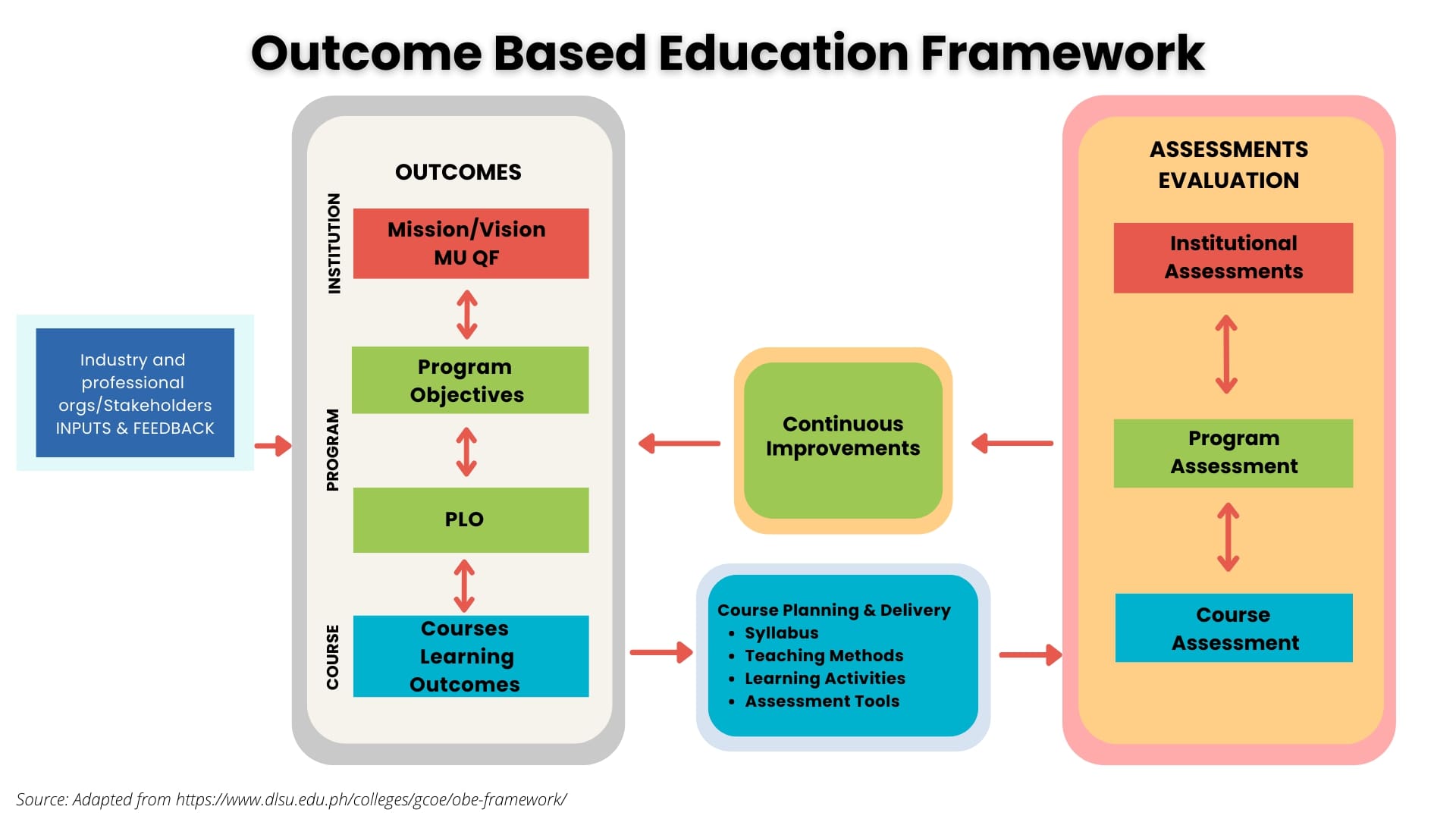
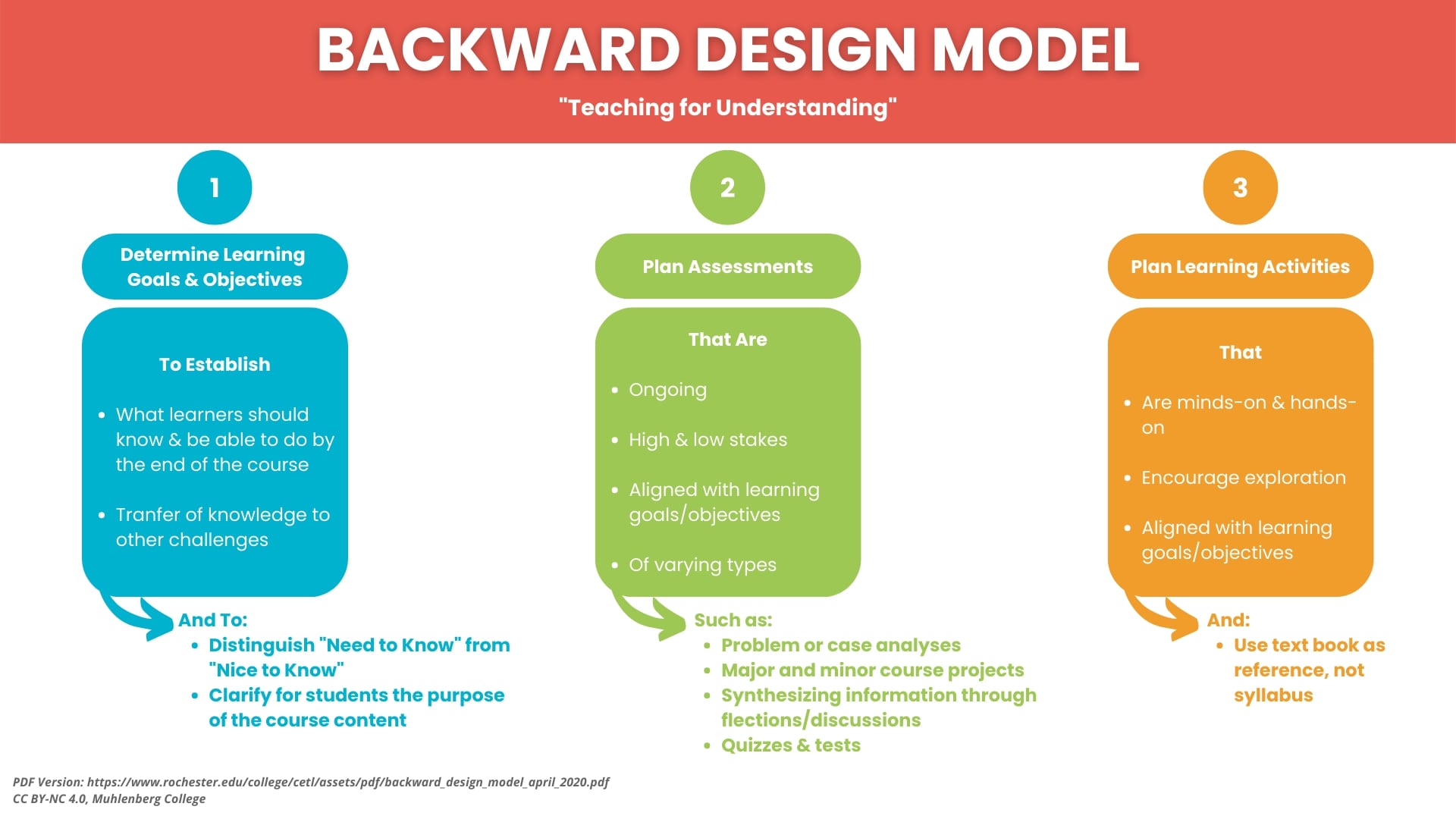
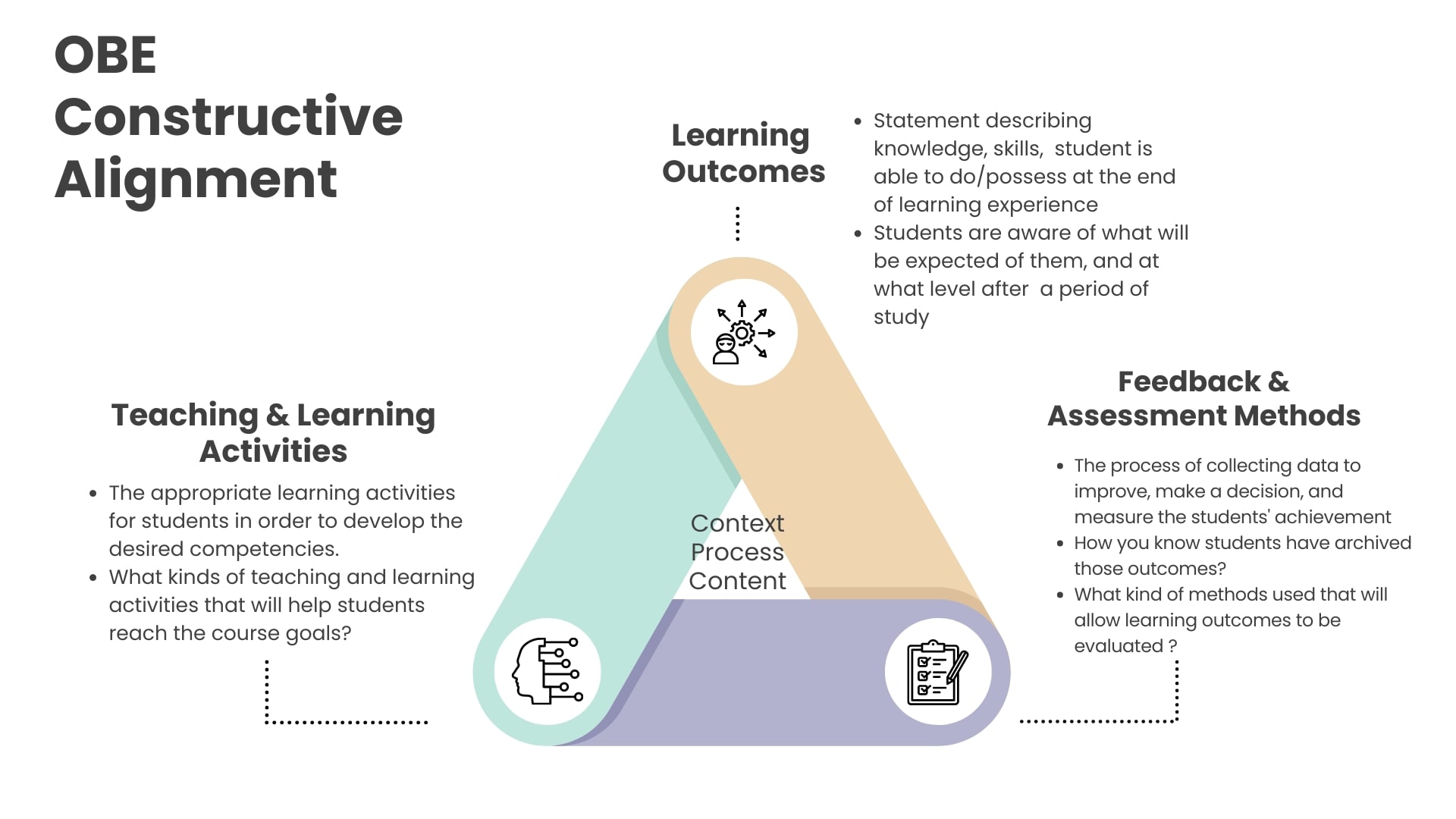
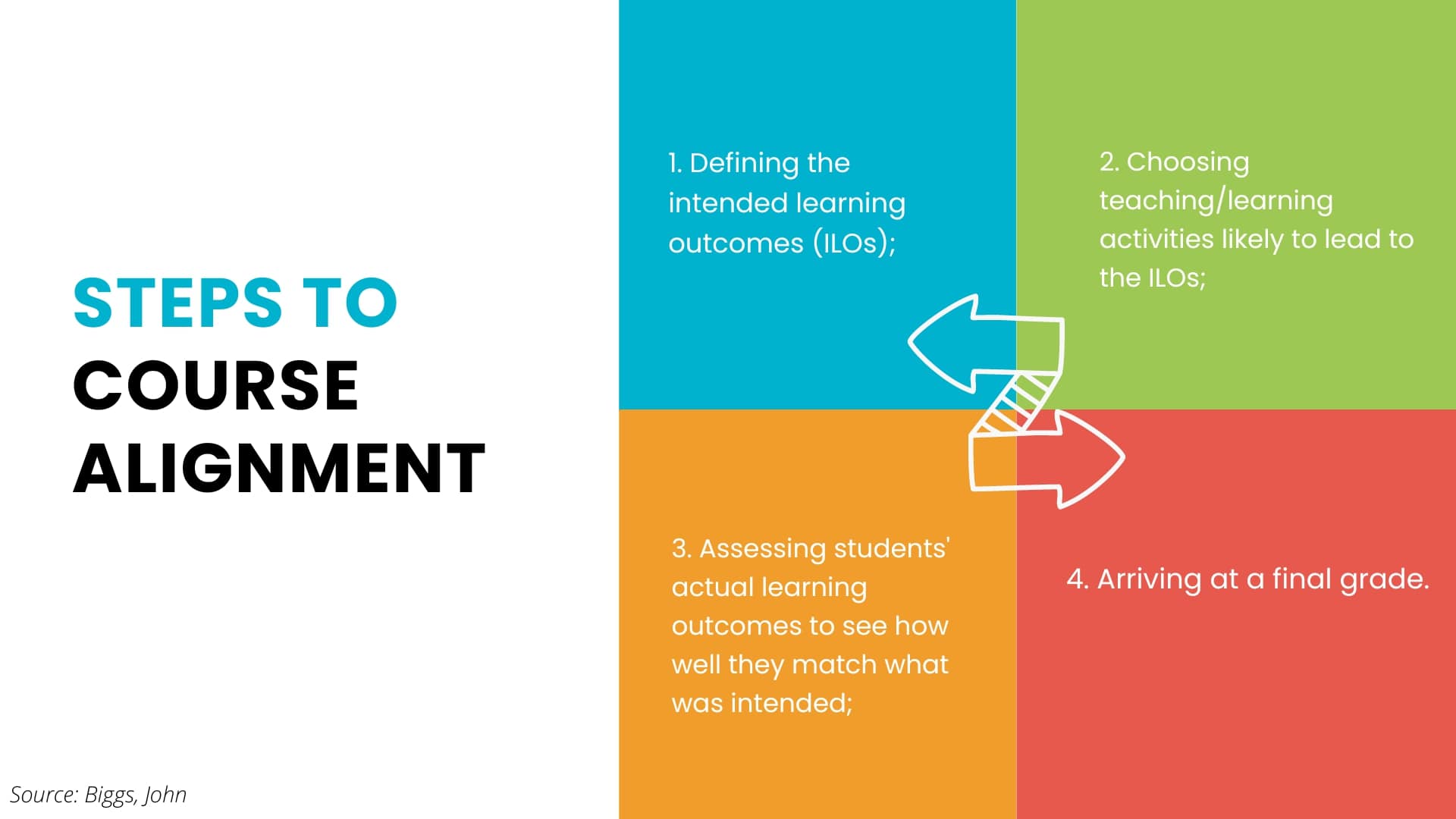
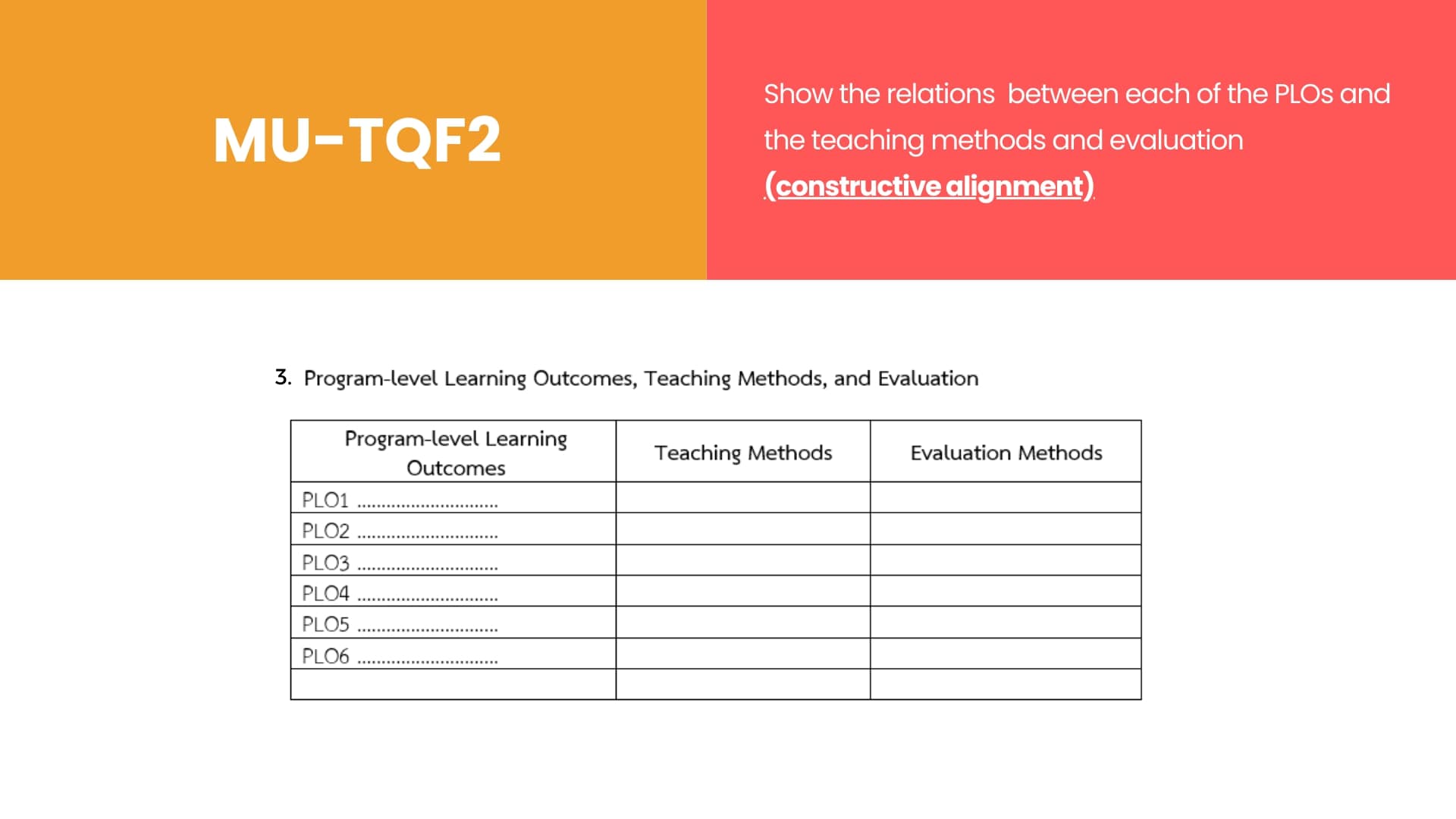
Outcome Based Education
Outcome-based Education is meant to be a student-centered learning model that bases the whole educational system around clearly defined goals (outcomes). Its model is designed in favor of making students demonstrate what they know and are able to do whatever the required outcomes are. OBE has been emphasized setting clear standards for observable, measurable outcomes. All teaching, learning and assessment activities need to be aligned with these intended learning outcomes. This is known as the principle of constructive alignment.
With the outcomes in mind, the course must be designed in a way that will lead the students to achieve those outcomes, and that’s when Bloom’s Taxonomy comes into play. Bloom’s Taxonomy is basically a classification system used to define and differentiate the level of human cognition. Developed by Benjamin Bloom, it was proposed that learning fit into one of the following three psychological domains:
- Cognitive domain – process information, knowledge and mental skills
- Affective domain – attitudes and feeling
- Psychomotor domain – manipulative, manual or psychical skills
Course Design

Constructive Alignment:
To drive a constructive alignment, you, as a facilitator, must be able to explain the reason and purpose behind everything you do or ask your students to do. The alignment helps you ensure that your pedagogical approaches and assessment methods connect with your learning outcomes, leading to course transparency and explicitly-designed course structure. This means you don’t teach one topic, assess another and expect students to develop or perform some skills they’ve never been prepared for.
The notion of constructive alignment is that students construct their own learning through a series of relevant learning activities. Teachers are responsible for designing the learning environment and activities that facilitate that learning (Biggs, 2013). The relationship between these three concepts are simply presented as “the triangle of effective learning”.
Setting Up for Aligned System:
The basics of good course design start with identifying what you want the students to learn by defining the course’s learning objectives. This will help you prioritize what teaching & learning activities, assessments, and other relevant content should be included in your course, to ensure that the students completed the course with desired skills and competencies. When breaking down the course learning objectives into smaller unit-levels, make sure that those smaller objectives can contribute to the desired course-level outcomes.
Next, writing learning objectives use action verbs as categorized by Bloom’s Taxonomy to hierarchically set up students’ skills from lower to higher-order. It will help you appropriately identify the students’ baseline level of knowledge and skills, and also know how to move from simple to more complex levels of competency classification. The notion is that you need to design the learning outcomes measurable and meaningful, rather than broad and intangible.
Examples of Learning Objectives
“By the end of this course, you will be able to…”
- Critically evaluate ……………………………………………….
- Apply fundamental principles ………………………………
- Explain why …………………………………………………………..
- Formulate ……………………………………………………………
- Identify and describe ……………………………………………
Once the learning objectives have been set, you must develop assessments, teaching strategies, and learning activities to ensure that every activity is accounted for achieving course goals, and those developed approaches are aligned with what you intend to measure.
Visit How to Write Course Learning Outcome for more information
Course process and forms
Visit Procedures and Forms for more information
Course Credit Hours Conversion – from clock hours per week to credit hours
Link: Clock to Credit Hour Converter | xls
How to use:
- Use first table to calculate credit hours for lecture/lab course and the second one for internship/training/fieldwork course
- Put a number of lecture/lab/internship/training/fieldwork hours per week in the box with red underline
- The table will calculate and show the following data:
- Structure of credit hours
- Lecture/Lab/Internship/Training/Fieldwork credits
- Total credits
- Total study hours per week
- Lecture/Lab/Internship/Training/Fieldwork hours per trimester
- Total study hours per trimester
Writing A Course Description
Course description is one of the main driving forces behind the students’ decision to take a course. It serves as an overview of content covered, knowledge and skills to be learned, and what benefits students will gain from enrolling. It should be clear, concise, and easy to understand. Though it focuses primarily on students, it can be accessed by the general public, including parents, prospective students, other universities for transferring credits, employers, and accrediting bodies.
- Should not be written in a complete sentence, phrases are preferred
- Should be clear and concise, exclude any introductory text such as this course provide…, the content cover…, participant will…, refrain from exemplifying or overexplaining, including using the words like for example, such as, and do not mention pedagogical approaches or strategies
- For Thai course descriptions, avoid any punctuations and English terms integration, and refer to Thai Royal Institute dictionary, or referenceable/industry-approved technical terms for any foreign academic terminology. If those words are in the process of entering common use and haven’t been fully accepted in mainstream language, transliteration is acceptable using Thai Royal Institute Transliteration System Guideline
- Thai and English course descriptions must be in alignment. Strictly follow the meaning of words are a must
- For English course descriptions, start with a capital letter followed by small letters, except for proper nouns. Use comma (,) to separate each item in a series that has the same function and form, and end the phrase with a semicolon (;)
- Omit using period (.) at the end of phrase
- Should refrain from using pronouns like we/I/you, or gendered pronouns like he/she
- Should be the concept-based description instead of a teaching topic/name of software/technology that changes term to term, to facilitate the flexibility of adjusting the lesson plan to keep pace with changes
Example:
ศรสว ๕๐๒ วิทยาระเบียบวิธีวิจัย ๒ (๒-๐-๔)
SIRE 502 Research Methodology
วิทยาระเบียบวิธีวิจัย และรูปแบบการวิจัย ประเภทต่างๆ การวิจัยเชิงสังเกต การวิจัยเชิงทดลอง การวิจัยเชิงคุณภาพ การประยุกต์กระบวนการทางวิทยาศาสตร์ ในการออกแบบงานวิจัย การกําหนดคําถาม และ สมมติฐานการวิจัย การพัฒนาข้อเสนอ การวิจัยเทคนิคการรวบรวมข้อมูลการจัดการและวิเคราะห์ข้อมูลการอ่านบทความวิจัยทางวิทยาศาสตร์วรรณกรรมโดยการค้นหาผ่านอุปกรณ์อิเล็กทรอนิกส์และแหล่งที่มาของข้อมูลในวิทยาศาสตร์การแพทย์
Research methodology and types of research; observational, experimental, qualitative researches; applications of scientific process in research design; formulation of research questions and hypotheses; research proposal development; technique of data collection, data management and analysis; critical reading of scientific research articles using literature search through electronic equipment and information sources in medical sciences
Learning Approaches
Several theories have been proposed speaking to the understanding that every student learns differently. Generally, learning styles refer to the preferential way each individual uses to learn, absorb, make sense, and retain information/knowledge. Despite the variation, the fundamental concept behind learning styles is the same: each student has their own learning styles, and prefers when the information is delivered in such a manner.
Active Learning
Active learning approach encourages students to be more involved in their learning journey, in order to construct new knowledge and create a more inclusive teaching and learning environment. Instructions are redesigned and aren’t limited to old ‘show and tell’ practices with students listening and doing what has been told, but rather emphasize the teacher role as a facilitator, who facilitate learning and guide learners to achieve the course goals, and also give positive and reassuring feedback to students.
- Team-Based learning (TBL)
Team-Based learning can be described as one version of flipped-classroom. It’s a structured form of small group learning designed around course concepts and student learning outcomes that emphasizes students’ preparation out of class and application of the knowledge in class. Students are strategically organized and grouped to work together throughout the course. The learnings are promoted through the systematic use of a team interacting regularly in structured- learning activities, while the inconsistencies between perceptions and new experience form the development of understanding and new knowledge. Before each course module students are supposed to do prior readings assigned by the instructor. While teacher is working as a guide to facilitate learning, students are required to follow the specific steps of TBL which includes pre-class preparation, readiness assurance process (Individual Readiness Assistant Test – iRAT, Team Readiness Assistant Test – tRAT, respectively) and followed by problem-solving activities requiring teams to make choices and report their solutions to specific, relevant problems.
- Game-Based Learning (GBL)
Game-based learning uses gaming principles to enhance the learning experience in a non-game context to encourage participation. The notions behind this approach are teaching through repetition, failure, and the attainment of course goals. This learning approach can help increase student participation, to make mistakes in a risk-free setting environment. The concept of GBL is to start with what outcomes instructors want the students to achieve, then the instructor incorporates the game elements into teaching which eventually allows students to learn through the process by themselves. This encourages more communication and teamwork among students. Despite the fun and learning with the use of game-based learning, there are challenges like more prior preparations, readiness for unexpected things that may happen during the game, and developing strategies that can be applied to people with different backgrounds and personalities.
- Problem-based learning (PBL)
Problem-Based learning is a teaching method where students incorporate self-directed learning and actively engage themselves with real-world projects. In order to report findings, students must beforehand determine what they need to learn, where they can acquire the information and what tools are needed to solve the problem. PBL encourages students to make meaningful connections across content areas, rather than thinking about each subject area in isolation. It also helps build 21st-century skills that students need to succeed such as developing deep content knowledge as well as critical thinking, creativity and communication skills. Students are provided with real cases giving them the opportunities to resolve the problems or issues.
Brain Based Learning
This teaching theory is based on the brain’s structure and function with the notion that if the brain is functioning right and not limited from executing its normal process, learning will occur. Therefore, in a traditional learning environment, such as desks in rows, teachers take the active role of teaching while students take more of a passive role. Such a traditional learning environment can sometimes discourage or hinder the nature of the brain process. The BBL approach helps teachers to adapt their style of teaching according to the brain’s exceptional features in order to maximize the learning process, and to understand students’ learning styles to create a better classroom environment and activities that can serve all types of students.
Visual Thinking and Doing
The concept of visual thinking can be simply described as “picture thinking” which relates to thinking through visual processing. In the field of education, visual thinking is a learning style where learners learn better and retain information when ideas and words are associated with images. It also makes it easier to understand complex data, improves the ability to think, and communicate. This style of learning is based on several theories such as Gestalt’s Principles of Grouping, which is used to explain human perception of groups and parts of objects, and how we gain meaningful information from perceptual scenes. This includes the law of hierarchy where information is organized in natural eyes’ movement and groups with layout such as using space, similarity and position of elements to create visual materials that can help learners seek patterns and construct connections, etc.
Digital Education Technology – Technological Pedagogical Content Knowledge or TPACK
It is a theory that was developed to explain the set of knowledge that teachers need to teach their students: subject, effective pedagogy, educational technology implementation. The three types of knowledge, TK-PK-CK, are independently combined and recombined within the model. When TK, PK, and CK are combined with TPK, PCK and TCK, they will form the triangulated areas that create TPACK, which reflects the relationships among all three areas in which teachers are performing.
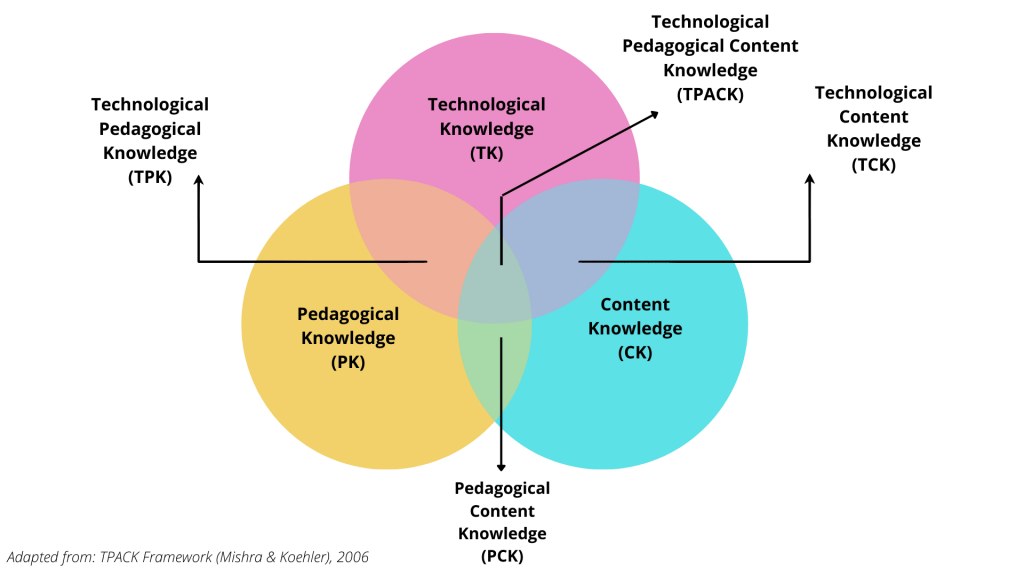
Adapted from: TPACK Framework (Mishra & Koehler, 2006)
Further Readings:
- 15 Learning Theories in Education (A Complete Summary) https://www.educationcorner.com/learning-theories-in-education/
- How To Teach? https://www.case-ka.eu/index.html%3Fp=2740.html
- Teaching Methods https://teach.com/what/teachers-know/teaching-methods/
2.1. Outcome Based Education
Outcome Based Education
Outcome-based Education is meant to be a student-centered learning model that bases the whole educational system around clearly defined goals (outcomes). Its model is designed in favor of making students demonstrate what they know and are able to do whatever the required outcomes are. OBE has been emphasized setting clear standards for observable, measurable outcomes. All teaching, learning and assessment activities need to be aligned with these intended learning outcomes. This is known as the principle of constructive alignment.
With the outcomes in mind, the course must be designed in a way that will lead the students to achieve those outcomes, and that’s when Bloom’s Taxonomy comes into play. Bloom’s Taxonomy is basically a classification system used to define and differentiate the level of human cognition. Developed by Benjamin Bloom, it was proposed that learning fit into one of the following three psychological domains:
- Cognitive domain – process information, knowledge and mental skills
- Affective domain – attitudes and feeling
- Psychomotor domain – manipulative, manual or psychical skills
Course Design

Constructive Alignment:
To drive a constructive alignment, you, as a facilitator, must be able to explain the reason and purpose behind everything you do or ask your students to do. The alignment helps you ensure that your pedagogical approaches and assessment methods connect with your learning outcomes, leading to course transparency and explicitly-designed course structure. This means you don’t teach one topic, assess another and expect students to develop or perform some skills they’ve never been prepared for.
The notion of constructive alignment is that students construct their own learning through a series of relevant learning activities. Teachers are responsible for designing the learning environment and activities that facilitate that learning (Biggs, 2013). The relationship between these three concepts are simply presented as “the triangle of effective learning”.
Setting Up for Aligned System:
The basics of good course design start with identifying what you want the students to learn by defining the course’s learning objectives. This will help you prioritize what teaching & learning activities, assessments, and other relevant content should be included in your course, to ensure that the students completed the course with desired skills and competencies. When breaking down the course learning objectives into smaller unit-levels, make sure that those smaller objectives can contribute to the desired course-level outcomes.
Next, writing learning objectives use action verbs as categorized by Bloom’s Taxonomy to hierarchically set up students’ skills from lower to higher-order. It will help you appropriately identify the students’ baseline level of knowledge and skills, and also know how to move from simple to more complex levels of competency classification. The notion is that you need to design the learning outcomes measurable and meaningful, rather than broad and intangible.
Examples of Learning Objectives
“By the end of this course, you will be able to…”
- Critically evaluate ……………………………………………….
- Apply fundamental principles ………………………………
- Explain why …………………………………………………………..
- Formulate ……………………………………………………………
- Identify and describe ……………………………………………
Once the learning objectives have been set, you must develop assessments, teaching strategies, and learning activities to ensure that every activity is accounted for achieving course goals, and those developed approaches are aligned with what you intend to measure.
Visit How to Write Course Learning Outcome for more information
Course process and forms
- Opening New Curriculum
- Revising Curriculum
- [MU-CUR 02] Request for approval on offering new program submitted to MU Dean/ MU Council Meeting
- [MU-CUR 03] Request for approval on revising program submitted to MU Dean/ MU Council Meeting
- [SMO 08] Revise Program (Minor Change)
- [SMO 08] Change Lecturers in charge of the program and program designated lecturers
- MU-Template for Degree Profile
- Closing Curriculum
- TQF Forms & MU Degree Profile Template
- [TQF 2] Program Specification (Thai) (English)
- [TQF 3] General Education Course(Doc)
- [TQF 3] Specific Course(Doc)
- [TQF 4] Specification of Field Training Experience(Docx)
- [TQF 5] Report on Course Implementation(Docx)
- [TQF 6] Report on the Implementation of Field Training
- [TQF 7] Report on Implementation of Program
- MU Degree Profile Template
Course Credit Hours Conversion – from clock hours per week to credit hours
Link: Clock to Credit Hour Converter | xls
How to use:
- Use first table to calculate credit hours for lecture/lab course and the second one for internship/training/fieldwork course
- Put a number of lecture/lab/internship/training/fieldwork hours per week in the box with red underline
- The table will calculate and show the following data:
- Structure of credit hours
- Lecture/Lab/Internship/Training/Fieldwork credits
- Total credits
- Total study hours per week
- Lecture/Lab/Internship/Training/Fieldwork hours per trimester
- Total study hours per trimester
Writing A Course Description
Course description is one of the main driving forces behind the students’ decision to take a course. It serves as an overview of content covered, knowledge and skills to be learned, and what benefits students will gain from enrolling. It should be clear, concise, and easy to understand. Though it focuses primarily on students, it can be accessed by the general public, including parents, prospective students, other universities for transferring credits, employers, and accrediting bodies.
- Should not be written in a complete sentence, phrases are preferred
- Should be clear and concise, exclude any introductory text such as this course provide…, the content cover…, participant will…, refrain from exemplifying or overexplaining, including using the words like for example, such as, and do not mention pedagogical approaches or strategies
- For Thai course descriptions, avoid any punctuations and English terms integration, and refer to Thai Royal Institute dictionary, or referenceable/industry-approved technical terms for any foreign academic terminology. If those words are in the process of entering common use and haven’t been fully accepted in mainstream language, transliteration is acceptable using Thai Royal Institute Transliteration System Guideline
- Thai and English course descriptions must be in alignment. Strictly follow the meaning of words are a must
- For English course descriptions, start with a capital letter followed by small letters, except for proper nouns. Use comma (,) to separate each item in a series that has the same function and form, and end the phrase with a semicolon (;)
- Omit using period (.) at the end of phrase
- Should refrain from using pronouns like we/I/you, or gendered pronouns like he/she
- Should be the concept-based description instead of a teaching topic/name of software/technology that changes term to term, to facilitate the flexibility of adjusting the lesson plan to keep pace with changes
Example:
ศรสว ๕๐๒ วิทยาระเบียบวิธีวิจัย ๒ (๒-๐-๔)
SIRE 502 Research Methodology
วิทยาระเบียบวิธีวิจัย และรูปแบบการวิจัย ประเภทต่างๆ การวิจัยเชิงสังเกต การวิจัยเชิงทดลอง การวิจัยเชิงคุณภาพ การประยุกต์กระบวนการทางวิทยาศาสตร์ ในการออกแบบงานวิจัย การกําหนดคําถาม และ สมมติฐานการวิจัย การพัฒนาข้อเสนอ การวิจัยเทคนิคการรวบรวมข้อมูลการจัดการและวิเคราะห์ข้อมูลการอ่านบทความวิจัยทางวิทยาศาสตร์วรรณกรรมโดยการค้นหาผ่านอุปกรณ์อิเล็กทรอนิกส์และแหล่งที่มาของข้อมูลในวิทยาศาสตร์การแพทย์
Research methodology and types of research; observational, experimental, qualitative researches; applications of scientific process in research design; formulation of research questions and hypotheses; research proposal development; technique of data collection, data management and analysis; critical reading of scientific research articles using literature search through electronic equipment and information sources in medical sciences
2.2 Learning Theories
Learning Approaches
Several theories have been proposed speaking to the understanding that every student learns differently. Generally, learning styles refer to the preferential way each individual uses to learn, absorb, make sense, and retain information/knowledge. Despite the variation, the fundamental concept behind learning styles is the same: each student has their own learning styles, and prefers when the information is delivered in such a manner.
Active Learning
Active learning approach encourages students to be more involved in their learning journey, in order to construct new knowledge and create a more inclusive teaching and learning environment. Instructions are redesigned and aren’t limited to old ‘show and tell’ practices with students listening and doing what has been told, but rather emphasize the teacher role as a facilitator, who facilitate learning and guide learners to achieve the course goals, and also give positive and reassuring feedback to students.
- Team-Based learning (TBL)
Team-Based learning can be described as one version of flipped-classroom. It’s a structured form of small group learning designed around course concepts and student learning outcomes that emphasizes students’ preparation out of class and application of the knowledge in class. Students are strategically organized and grouped to work together throughout the course. The learnings are promoted through the systematic use of a team interacting regularly in structured- learning activities, while the inconsistencies between perceptions and new experience form the development of understanding and new knowledge. Before each course module students are supposed to do prior readings assigned by the instructor. While teacher is working as a guide to facilitate learning, students are required to follow the specific steps of TBL which includes pre-class preparation, readiness assurance process (Individual Readiness Assistant Test – iRAT, Team Readiness Assistant Test – tRAT, respectively) and followed by problem-solving activities requiring teams to make choices and report their solutions to specific, relevant problems.
- Game-Based Learning (GBL)
Game-based learning uses gaming principles to enhance the learning experience in a non-game context to encourage participation. The notions behind this approach are teaching through repetition, failure, and the attainment of course goals. This learning approach can help increase student participation, to make mistakes in a risk-free setting environment. The concept of GBL is to start with what outcomes instructors want the students to achieve, then the instructor incorporates the game elements into teaching which eventually allows students to learn through the process by themselves. This encourages more communication and teamwork among students. Despite the fun and learning with the use of game-based learning, there are challenges like more prior preparations, readiness for unexpected things that may happen during the game, and developing strategies that can be applied to people with different backgrounds and personalities.
- Problem-based learning (PBL)
Problem-Based learning is a teaching method where students incorporate self-directed learning and actively engage themselves with real-world projects. In order to report findings, students must beforehand determine what they need to learn, where they can acquire the information and what tools are needed to solve the problem. PBL encourages students to make meaningful connections across content areas, rather than thinking about each subject area in isolation. It also helps build 21st-century skills that students need to succeed such as developing deep content knowledge as well as critical thinking, creativity and communication skills. Students are provided with real cases giving them the opportunities to resolve the problems or issues.
Brain Based Learning
This teaching theory is based on the brain’s structure and function with the notion that if the brain is functioning right and not limited from executing its normal process, learning will occur. Therefore, in a traditional learning environment, such as desks in rows, teachers take the active role of teaching while students take more of a passive role. Such a traditional learning environment can sometimes discourage or hinder the nature of the brain process. The BBL approach helps teachers to adapt their style of teaching according to the brain’s exceptional features in order to maximize the learning process, and to understand students’ learning styles to create a better classroom environment and activities that can serve all types of students.
Visual Thinking and Doing
The concept of visual thinking can be simply described as “picture thinking” which relates to thinking through visual processing. In the field of education, visual thinking is a learning style where learners learn better and retain information when ideas and words are associated with images. It also makes it easier to understand complex data, improves the ability to think, and communicate. This style of learning is based on several theories such as Gestalt’s Principles of Grouping, which is used to explain human perception of groups and parts of objects, and how we gain meaningful information from perceptual scenes. This includes the law of hierarchy where information is organized in natural eyes’ movement and groups with layout such as using space, similarity and position of elements to create visual materials that can help learners seek patterns and construct connections, etc.
Digital Education Technology – Technological Pedagogical Content Knowledge or TPACK
It is a theory that was developed to explain the set of knowledge that teachers need to teach their students: subject, effective pedagogy, educational technology implementation. The three types of knowledge, TK-PK-CK, are independently combined and recombined within the model. When TK, PK, and CK are combined with TPK, PCK and TCK, they will form the triangulated areas that create TPACK, which reflects the relationships among all three areas in which teachers are performing.

Adapted from: TPACK Framework (Mishra & Koehler, 2006)
Further Readings:
- 15 Learning Theories in Education (A Complete Summary) https://www.educationcorner.com/learning-theories-in-education/
- How To Teach? https://www.case-ka.eu/index.html%3Fp=2740.html
- Teaching Methods https://teach.com/what/teachers-know/teaching-methods/


